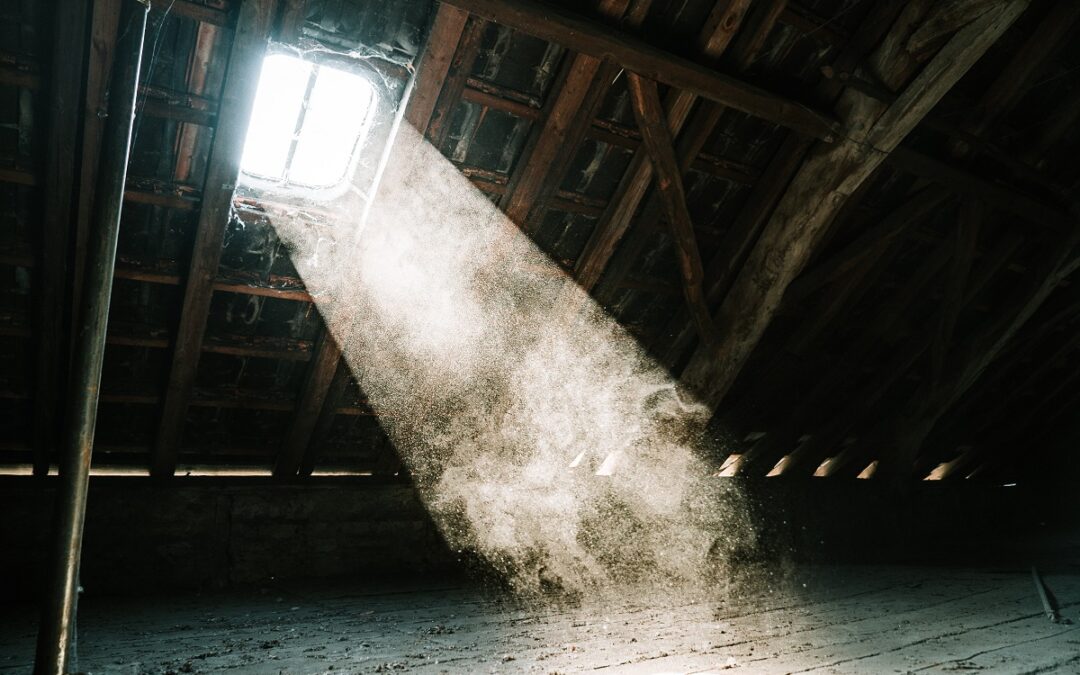Attics are prone to mold growth, providing just the right conditions (hot, humid) and an abundant food source from the wood sheathing. When mold grows on surfaces, spores can be released into the air where they can be easily inhaled, leading to a variety of negative health effects. Read on to learn about how to identify attic mold, how to remove it and how to prevent it from coming back.
Signs of Possible Attic Mold
- Stains: Black or dark discoloration on the plywood in your attic indicates mold growth and should be evaluated by a professional.
- Smells: If your attic smells musty or moldy, there is a moisture problem, and it should be checked out right away.
- Temperature: If properly ventilated, attics should feel breezy. If it feels stuffy to you, search for possible attic mold problems and consider ways to improve ventilation.
- Water Vapor/Leaks: Scrutinize smoke detectors, bath fans, light fixtures, etc. for dripping water. This is a good sign that the floor above, or the attic, has excessive moisture that needs to be addressed.
- Wet Insulation: If your insulation is wet, it is a good indicator that you have excess moisture in the area and mold growth.
How to Remove Mold in Your Attic
Removing attic mold is difficult and dangerous, even for professionals. One wrong step and you could step through floor joists, causing serious injury. In addition, more severe mold growth may require commercial-strength cleaners and equipment to completely contain it. It is strongly recommended that you call a professional mold remediation company to assist you in removing mold from your attic. Doing so will bring you peace of mind that the air in your home is clear of mold particles that can have negative impacts on your health and your family’s health. They will also be able to help you take steps in preventing new mold growth.
Prevention
Ridding your home or business of mold that’s been growing for a while is much harder than preventing it. Follow these steps to get ahead of mold and to ensure your space stays clean.
Ensure Adequate Ventilation
Ventilation should be placed in a way that allows air to enter from along the eaves and exit through the roof’s peak. One rule of thumb to consider is that there should be one square foot of attic ventilation per 300 square feet of ceiling space. In the summer, on a hot day, touch the ceiling with your bare hand. If it is warm, there is a good chance that hot air is being stored in your attic and additional ventilation is needed. In the winter, if you notice ice building up on your eaves, your attic isn’t well-ventilated. Check the temperature of the attic and look for condensation or frost on the attic’s ceiling. Roof, soffit, and gable vents can improve ventilation, and the benefits of improved ventilation are plentiful.
Install Proper Bathroom and/or Kitchen Fan Exhausts
Kitchen fans keep fresh air circulating and remove particles, smoke, carcinogens, and odors from your indoor air. A kitchen exhaust fan is usually located directly over the kitchen stove and should be ducted to exhaust outside of the home, not in the attic or crawlspace. Bathrooms generate a huge amount of moisture, and proper bathroom fans are critical for removing warm, wet air and drying the moist air that accumulates on surfaces so that it doesn’t find its way into your ceilings and walls. It is recommended that you run the bathroom exhaust fan for 30 minutes after each shower, leaving the bathroom door open so that moist air can be properly pushed out.
Inspect Your Roof
Check rafters, sheathing, and joists regularly for dark discoloration or staining of wood. Roof valleys, where two roofs join in an angle, are especially susceptible to leaks. Places where dissimilar materials join together are prone to moisture intrusion.
Remove Attic Mold with Action 911
Improper or delayed action in cleaning up attic mold can result in adverse health conditions for your family. The team of professionals at Action 911 has the proper training and education and will make sure attic mold removal is done right. Call Action 911 as soon as you suspect a problem.

